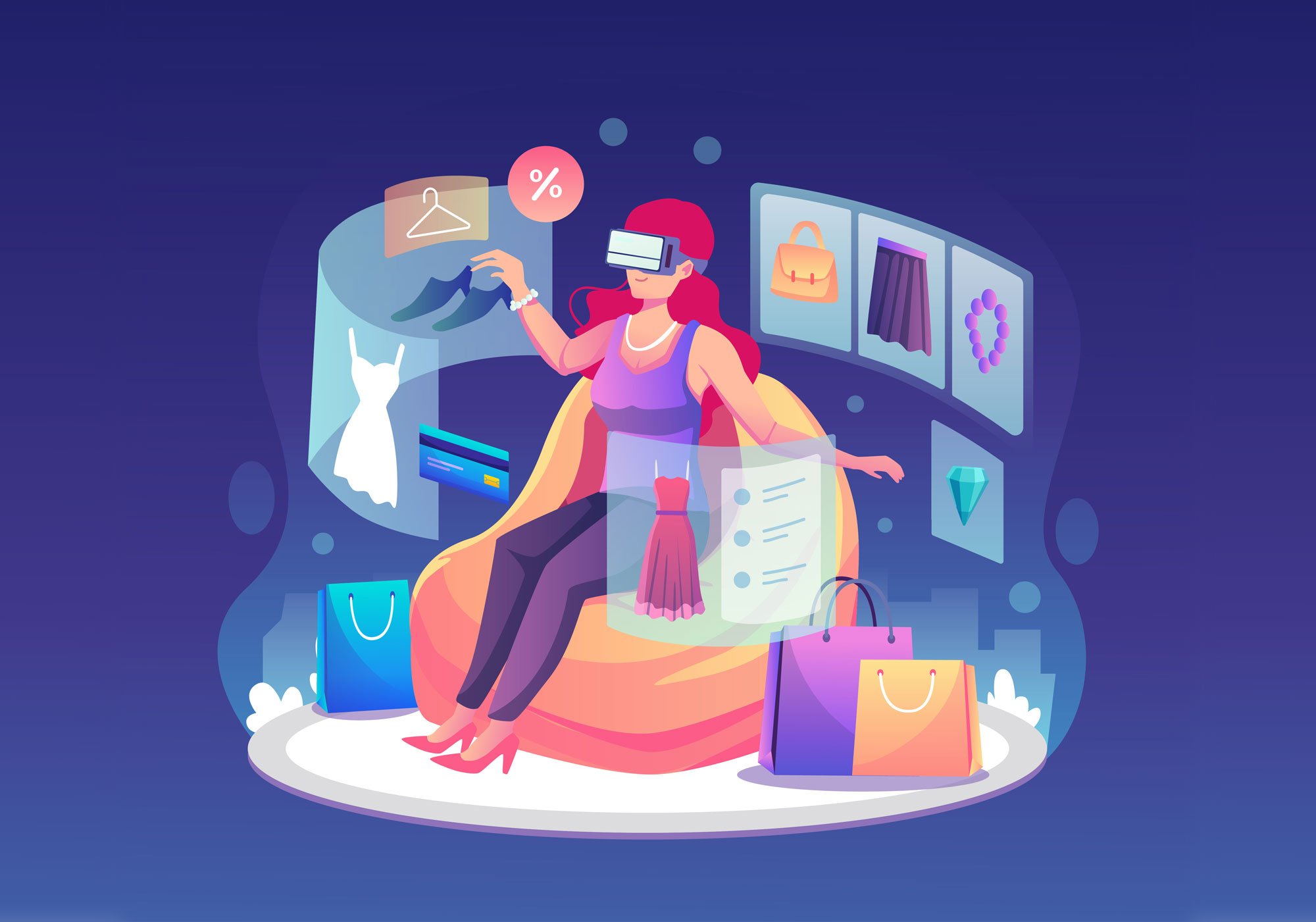10 not-to-be-missed retail trends for 2023
As technology evolves, the retail sector needs to keep pace. It’s the only way to remain competitive and successful. In the coming years, new trends will appear and may change the business landscape radically. This article looks into the ten retail trends that are expected to be the most influential in 2023. They include virtual-reality shopping, artificial intelligence (AI) technology in stores, and big-data insights. These developments are expected to shape customer-experience expectations, strengthen customer loyalty and generate more sales.
The further growth of online shopping
With the digital era continuing to develop, online shopping will become more popular in 2023. Consumers will be able to shop, anytime, anywhere, and have their purchases delivered directly to their homes.
The explosion in digital shopping means that to remain competitive, retailers need to concentrate on offering excellent customer experiences on all platforms. From personalised recommendations and promotions to easy payment methods and fast delivery, companies need to create seamless user-experiences from beginning to end. At the same time, companies need to offer unique products or services that are specifically tuned to their customers and that stand out from the masses.
The increase in mobile shopping
Technological progress means shopping on your smartphone is becoming increasingly popular thanks to its ease and accessibility. This trend is expected to continue in 2023 as more shoppers use their smartphones to make purchases at their favourite webshops.
Greater personalisation based on consumer desires
Retailers are beginning to realise that personalising the customer experience on the basis of customer preferences and habits leads to greater loyalty and income. In 2023, this trend is expected to become more pronounced as retailers direct even greater efforts towards creating unique experiences that are tailored to individual customers.
Nike launched its Nike By You service, with which everyone can fully tailor a pair of sneakers to their own personal tastes. This is just one example of a brand responding to the growing request for personalised, unique products that, in one way or another, reflect the consumer’s personality or style.
The rise of artificial intelligence (AI) in the retail sector
AI is becoming an increasingly important resource in the search for ways to automate processes, improve customer service and offer product recommendations. AI technologies such as machine learning and natural language processing will be used more commonly by retailers to better respond to customer needs.
According to Forbes, technologies such as sensors, beacons and facial recognition will also be used in the near future as a means of customising customer experiences based on behaviours or preferences from the past. It will allow retailers to create unique experiences for every customer, making them feel special and valued. A store could, for example, send personalised messages to clients when they pass by certain articles in the aisle or offer discounts on articles they frequently purchase. Discount vouchers sent to mobile phones will play a role here too.
Retailers can streamline their activities by automating certain daily tasks, such as stock management, order processing and customer service. As well as this, automated technologies such as an AI-driven chatbots are being used to make personalised recommendations and help clients with questions.
HighCo has also launched its AI coupon. HighCo COUPON[AI] is a unique techno-solution on the market that allows to collect and engage first party data.
Expansion of omnichannel strategies with retailers
Omnichannel strategies put clients in a position to use multiple channels—online, mobile or physical stores—to seamlessly shop via a single platform or app. This trend has been gaining momentum in recent years. It’s expected to continue doing so in 2023, with retailers further developing omnichannel strategies to meet the demands of modern consumers who expect flawless shopping experiences, regardless of where they shop or what device they use.
The focus of hybrid shopping is on bringing the best of two worlds—online and offline—to create customer journeys that meet all requirements. In the case of offline shopping, this means understanding who we are and what we want when we walk into a store—just as an e-tailer would do when we arrive on their website. In the world of online retail, this means methods need to be developed to offer the same shopping experience as in the real world. This is possible using innovative technologies such as virtual reality (VR) and augmented reality (AR). We discuss this topic in more detail below.
HighCo DATA is the market leader in couponing & clearing
Issuing a coupon is a direct reward for your consumers. It promotes their purchasing power. This results in the promotion being directly associated with your brand; the coupon is seen as a gift from the brand to the consumer. This influences their appreciation of your brand, increasing your turnover.
Grab the opportunity to work with HighCo Data and quickly increase your customer loyalty. Contact us now!
Growth of subscription services
Subscription-based services are becoming increasingly popular due to their ability to generate returning income streams and keep customers regularly involved with brands throughout the year. In 2023, subscription-based services are expected to continue increasing as more retailers offer them to build customer loyalty and create extra sales opportunities.
A nice example is the Amazon subscription where customers can automatically have products delivered to their homes every month with an attractive discount.
New trends and technologies: augmented reality (AR) & virtual reality (VR)
AR and VR technologies have slowly gained ground in the retail sector in recent years. The expectation is that this trend will increase in 2023 as more retailers use these technologies for both online and offline shopping. By adding interactive elements, such as virtual fittings or product demonstrations, they will make shopping easier and more fun for customers.
Clothing brand Hugo Boss has a virtual fitting room that allows clients to try on virtual clothing with the help of digital representations of themselves.
As shoppers become more technically educated, the retail industry is evolving to meet their demands. This trend is aimed at the creation of an uplifting and interactive shopping experience for customers. It goes further than just selling products. It contains a variety of options, such as VR, AR, personalised shopping experiences and much more.
HighCo has also launched its AI coupon. HighCo COUPON[AI] is a unique techno-solution on the market that allows to collect and engage first party data.
Insta-shopping
Retailers must not overlook the 2.65 billion people who use social media, but instead, carefully incorporate them in their marketing strategies. This is why social-media giants are now testing ways of integrating payment platforms. Instagram is one of the first to do this, although it is still experimental.
In the coming years, social networks will not just be places to chat and stay up to date with what your friends are doing in their daily lives. They will also be how retailers remain in contact with their customers. In fact, 60% of Instagram users are already using the platform to find and buy products. The addition of a native payment system will only accelerate this process.
Sustainable entrepreneurship
In the retail world, sustainability is a growing trend that is expected to become increasingly dominant in 2023. As consumer requests for environmentally friendly products increase, companies will need to adapt to remain competitive.
Stores can switch to renewable energy sources and use recycled materials. But they will also need to consider investing in sustainable practices, such as reusable packaging and biodegradable materials, to cater for environmentally conscious customers who would rather not contribute to unnecessary waste. This actually stimulates customers who use these environmentally friendly options to behave even more sustainably in the long term.
Finally, brands will need to be transparent about their efforts in the area of sustainability so that customers will be able to make well-informed decisions.
Data analysis and insights
Data analysis and data-driven insights are becoming ever more important for companies because they help in the creation of targeted products, services and marketing strategies. Big data can also be used to improve customer services and loyalty programmes and to streamline processes such as stock management. By making use of data-driven insights, retailers gain a competitive advantage over their rivals and maximise efficiency.
Today’s technology makes data analysis much more efficient than ever before. AI networks can quickly process complex data sets from multiple sources and deliver valuable insights into customer behaviour, market trends, product performance and more. Retailers need to use this technology if they wish to remain relevant in the coming years. AI offers in-depth analyses and makes more accurate predictions possible, revealing future trends that will be influential on company performance.
In short, retail will continue developing at high speeds. As technology becomes more integrated in our lives, retailers need to keep up with the latest trends and adapt their strategies accordingly. These ten retail trends for 2023 are undoubtedly just the beginning of a new wave of opportunities in the retail world. In the end, it’s up to retailers themselves to determine which of these trends best suit their target groups and company goals.
Share this
You May Also Like
These Related Stories

Retail and digital world: How retailers anticipate customer behaviour
.png)
Introduction to Mobile Coupons

No Comments Yet
Let us know what you think